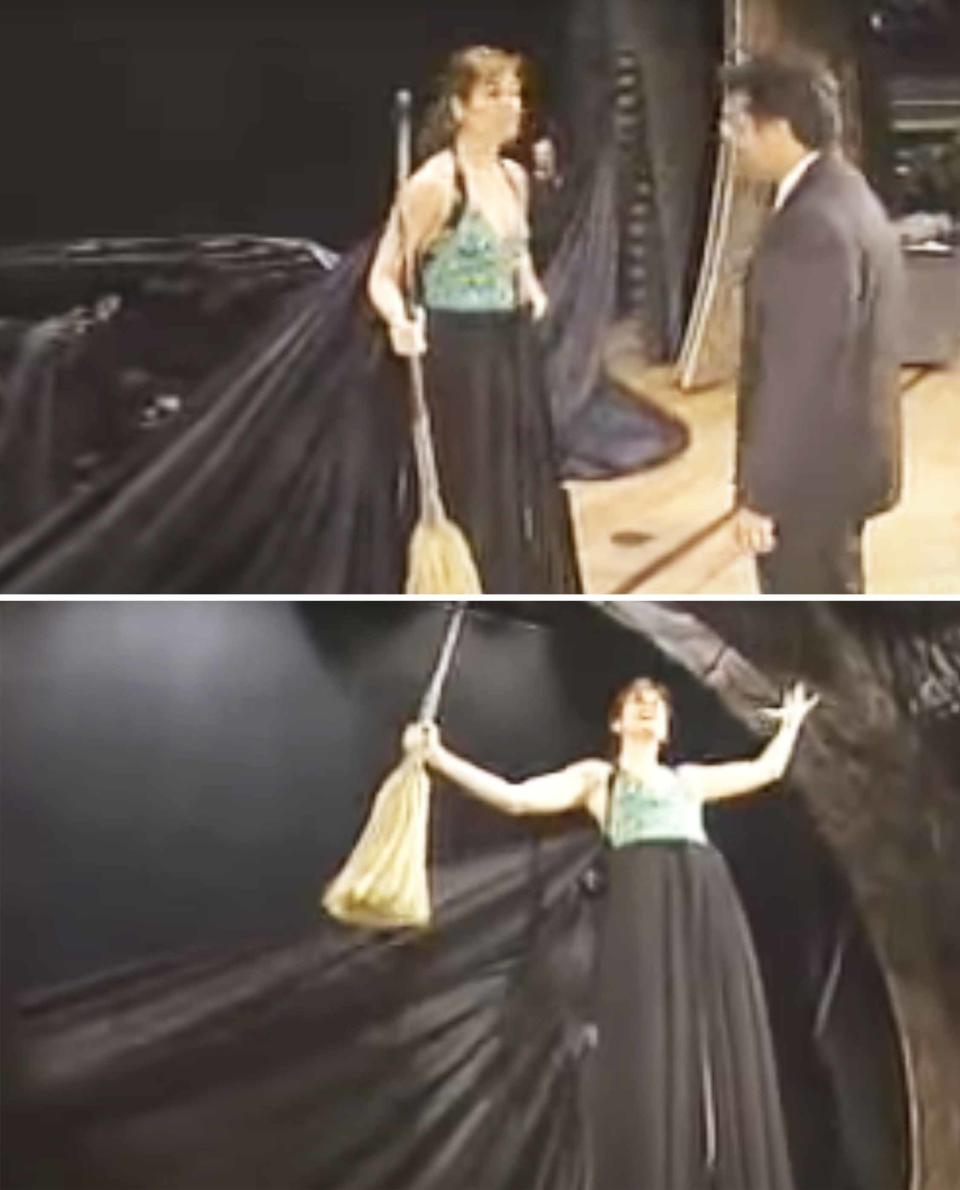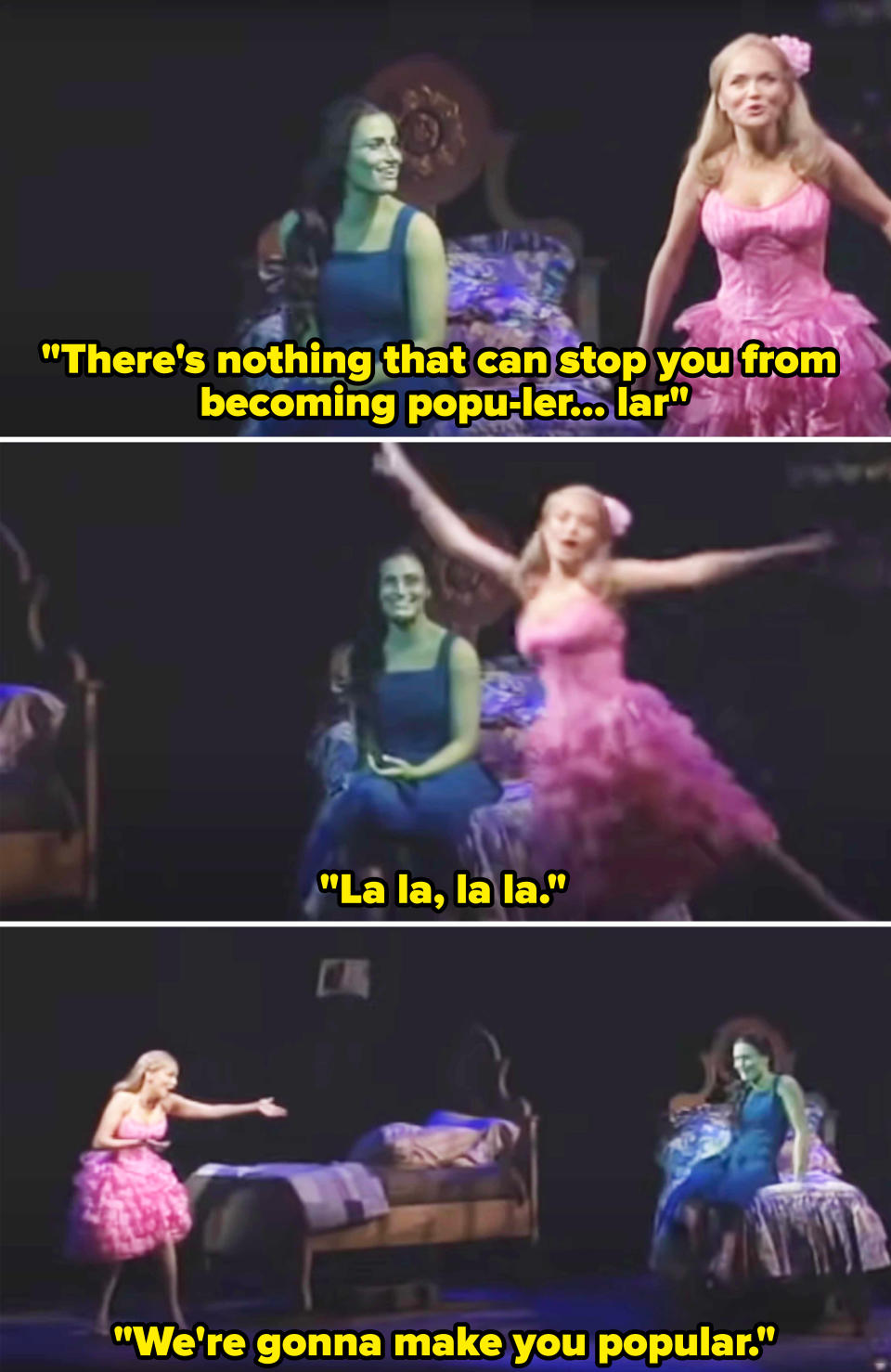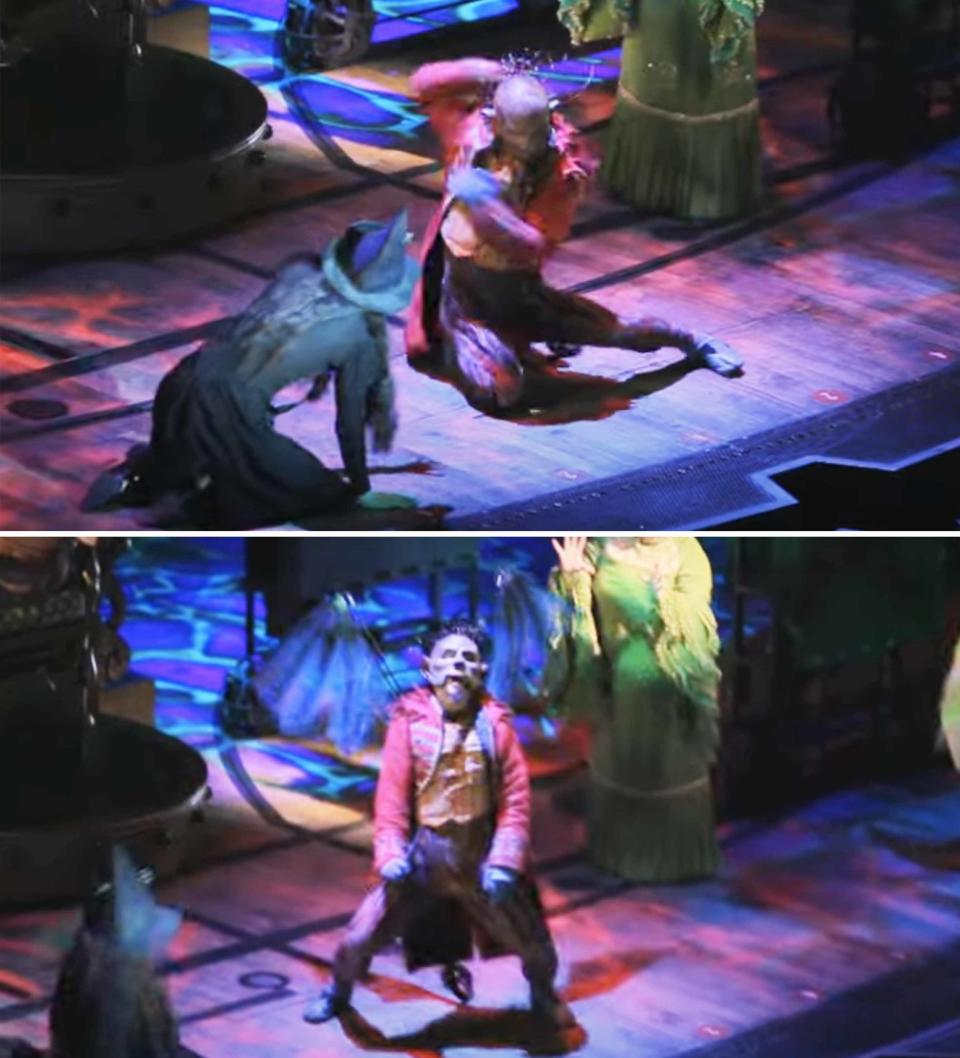21 "Wicked" Behind-The-Scenes Facts That'll Make You See This Broadway Show In A Whole New Way
1.First, the process for painting actors green for Elphaba in Wicked is so streamlined now, it only takes roughly 20–30 minutes. Chromacake in Landscape Green by MAC is what is used for the green base, and it's applied using a paintbrush and a mixture of the Chromacake and water.

"It's almost like a watercolor," explained makeup designer Joe Dulude II. After the base of green is applied, the makeup artist then defines the actor's features, like their eyes, cheekbones, mouth, etc., using beige, brown, black, and purple. Joe added, "The whole point was to make it look like skin, not look like makeup."
2.Throughout the show, there are constantly touch-ups to Elphaba's makeup when the actor isn't onstage. Not only is it to touch up the green, but it also shows the evolution of Elphaba's character. In Act 2, her makeup gets darker and "more dramatic" with winged eyeliner, more contour, and a darker lipstick.

Elphaba's makeup look in Act 2 is often referred to as "glam Elphaba makeup." Joe explained, "Makeup-wise, you can see a change from her character from simple, basic, not wearing any makeup per se, and then going into something that is much more dramatic, and like she's come into her own now."
3.Lindsay Mendez, who starred as Elphaba on Broadway in 2013 for the 10th anniversary, said that after being painted green for nine months, eight times a week, she would find green makeup "in the pores of [her] skin" long after she finished her run in the show.

She explained that she would have "green moles" because the makeup would go into her skin. "Long after I was done with Wicked, I would still have, like, green makeup in my pores that I would have to try and get out. It was pretty gnarly."
4.The now-iconic riff at the end of "Defying Gravity" was something Idina Menzel brought to the song after she was cast as Elphaba. Kristin Chenoweth, who played Glinda opposite Idina, recalled that the notes weren't explicitly written until Idina joined the production.

Idina also recalled that "So if You Care to Find Me" was originally written much lower, but she said, "Can I please take that out of the basement? She's going up here."
5.For Elphaba's big flying moment in "Defying Gravity," the actor playing Elphaba steps onto a small platform and presses their back against the mechanical device, and a belt locks them into place. A computer offstage signifies when they are safely locked in; if they aren't, it won't move. Also on the lift is fabric with the same color as Elphaba's outfit so it hides what she's standing on.

6.In "Popular," when Glinda runs around going, "La la...," it was something Kristin came up with, and now every Glinda who has taken over the role does it too. Kristin said she did that little dance because she imagined Glinda "in her room growing up. She probably loved ballet. She was a girly girl."

"So I went with the idea that she probably practiced and she wasn’t any good," Kristin added. Meanwhile, Idina said she loved watching Kristin first figure out the blocking for "Popular" during rehearsals because she had "confidence" and knew immediately how she wanted it to look. Idina added, "Kristin can pick up the paper and hear the rhythm immediately. It was something I always aspired to."
7.During several early readings, there was originally a song called "Making Good," which was going to be the first song Elphaba sang before it was replaced by "The Wizard and I."

Composer and lyricist Stephen Schwartz said that after readings, no one ever mentioned that "Making Good" was their favorite, which he took as a bad sign. When Idina joined the cast, Stephen realized that he could make a song that was more "high energy" that fit Idina's personality more. He sped up "Making Good," but it still didn't work.
8.Another song that was changed after initial readings was "Which Way's the Party?," which was replaced with "Dancing Through Life." Stephen explained that "Which Way's the Party?" ultimately didn't introduce the character of Fiyero well enough.

He elaborated, saying, "I began to feel that the song needed to be more clearly a statement of Fiyero's philosophy of life. 'Which Way's the Party?' seemed to be functioning simply as an 'up number,' without really defining the character as much as I hoped it would."
9.The first seven notes of the classic Wizard of Oz song "Over the Rainbow" are used in what Stephen calls the "Unlimited Theme," which can be heard in "The Wizard and I," "For Good," "Defying Gravity," and more.

The reason only the first seven notes are used as a little Easter egg is reportedly to avoid those songs infringing on any copyright issues with Harold Arlen and E.Y. Harburg's original song.
10.Gregory Maguire, who wrote Wicked: The Life and Times of the Wicked Witch of the West, which the musical is based on, named the Wicked Witch of the West "Elphaba" after the letters "L," "F," and "B," aka the initials of L. Frank Baum, who wrote The Wonderful Wizard of Oz.

"Once I got it, I thought, Every time her name is spoken or sung, I will be tipping my hat to the original person who created her: Lyman Frank Baum," Gregory explained.
11.When designing Glinda's signature bubble gown for Wicked, Tony Award–winning costume designer Susan Hilferty was inspired by a 1950s Dior gown, as well as Princess Diana's wedding dress. However, she had to jump through some legal hoops because it looked too close to what Glinda wore in the movie The Wizard of Oz.

Susan explained that originally, they were only allowed to use the illustrations from the original book for inspiration, and they reportedly had "no rights to anything connected to the movie." So Susan wrote a letter to the production's lawyers detailing how her inspiration was actually Princess Diana, Queen Elizabeth, and Dior, not the film. The bubble inspiration ended up being fair game because it was determined that it originated from the Oz books, not the movie.
12.Also, Glinda's bubble dress weighs about 14 pounds and has gone through four iterations since Kristin wore it in 2003. The current dress includes 68,200 blue and white sequins that were handsewn onto the gown.

The current version of Glinda's dress is a petal skirt with two hoops, and there are 64 petals that make up the skirt portion of the dress.
13.As for Elphaba's final dress, Susan took inspiration from the Earth and gems in order to visually give "the sense of [Elphaba] being grounded," versus Glinda, who is "light, and bubbles, and air." Also, while the dress may appear black, it's actually filled with darker colors and was built using "over 40 yards of fabric."

The over 40 yards of fabric were stitched together in order to "have a continuous sense of being from the Earth. It's created to look like the lines you would see in a chunk of earth," according to Susan.
14.One of the biggest quick changes in the show is when the ensemble of roughly 17 actors have to change from the mob to students at Shiz University. They reportedly only have about a minute and a half to change into their Shiz uniforms, which includes changing costumes, wigs, and shoes.

Meanwhile, the hardest quick change for Glinda's dresser is happening at the same time, when she must go from the notable bubble dress to her Shiz uniform. Elphaba and Glinda's quick change to their Emerald City costumes also reportedly lasts only 15 seconds.
15.One of the toughest costume moments to nail down in Wicked was when Chistery sprouts wings and becomes a flying monkey. In order to give the illusion that he was growing wings right in front of the audience's eyes, the wings are attached to the harness underneath the costume, and then the actor pulls a string to deploy the wings on cue.

While wearing the wings, the actors can actually "catch a little air" when jumping around on the stage, but the mechanical wings are heavy and hard to turn in.
16.While writing "For Good," Stephen knew it was going to be a song about friends having to say goodbye, so in order to make it as authentic (and emotional) as possible, he actually asked his daughter for help with inspiration for the lyrics.

"I went to Jess with a yellow pad in hand and said, 'I want you to imagine that you're never going to see your friend Sarah again, and you have one chance to tell her what she means to you. What would you say?'" Stephen recalled.
17.Willemijn Verkaik currently holds the record for the longest-running Elphaba. She's played over 2,000 performances in Germany, the Netherlands, Broadway, and the West End. As a result, Willemijn has also performed the show in three different languages: Dutch, German, and English.

Speaking about portraying Elphaba for so long, Willemijn said, "It's one of the toughest roles in musical theater, I think, for a woman to play because it's a very emotional journey, but yet you also have to have the vocal range. The challenge is to every day do that again and have that stamina, and be able to go through all of the emotional stages that she goes through. That's hard work."
18.The fog that is seen onstage in Wicked has become a memorable aspect of the show, especially during the beginning, "Defying Gravity," and "As Long as You're Mine." In 2018, the Broadway production had reportedly used 942,000 pounds of dry ice over the 15 years the show had been running at the time.

By comparison, in 2018 the Broadway production used only 221 gallons of bubble fluid.
19.Eugene Lee, who won a Tony Award for Best Scenic Design for Wicked in 2004, was the scenic designer on Saturday Night Live from its premiere in 1975 until his death in 2023.

The simplistic and fast-paced nature of designing the 11 or 12 sets needed per show on Saturday Night Live helped Eugene come up with the stripped-down design for Wicked, which was inspired by clock gears.
20.The dragon, which looms over the Wicked stage, is actually a marionette that is operated by crew members. Each rope the crew members pull operates a different aspect of the dragon, whether it's the wings, the head, or another part.

There's also smoke in the dragon's mouth and its eyes light up, which happens mechanically.
21.And finally, the design of the massive Oz head that is seen in Wicked was inspired by how the Tin Man was put together in The Wizard of Oz. By looking at the Tin Man's costume in the movie, the set designers figured out the concept for how the Oz head would look if it were "built in Oz."

The head is then operated by a stagehand. A bike brake handle is essentially what operates the mouth so the stagehand can open and close it.


